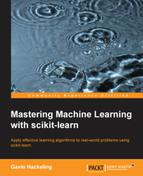In the previous examples, we assumed that the real relationship between the explanatory variables and the response variable is linear. This assumption is not always true. In this section, we will use polynomial regression, a special case of multiple linear regression that adds terms with degrees greater than one to the model. The real-world curvilinear relationship is captured when you transform the training data by adding polynomial terms, which are then fit in the same manner as in multiple linear regression. For ease of visualization, we will again use only one explanatory variable, the pizza's diameter. Let's compare linear regression with polynomial regression using the following datasets:
|
Training Instance |
Diameter (in inches) |
Price (in dollars) |
|---|---|---|
|
1 |
6 |
7 |
|
2 |
8 |
9 |
|
3 |
10 |
13 |
|
4 |
14 |
17.5 |
|
5 |
18 |
18 |
|
Testing Instance |
Diameter (in inches) |
Price (in dollars) |
|---|---|---|
|
1 |
6 |
7 |
|
2 |
8 |
9 |
|
3 |
10 |
13 |
|
4 |
14 |
17.5 |
Quadratic regression, or regression with a second order polynomial, is given by the following formula:
We are using only one explanatory variable, but the model now has three terms instead of two. The explanatory variable has been transformed and added as a third term to the model to capture the curvilinear relationship. Also, note that the equation for polynomial regression is the same as the equation for multiple linear regression in vector notation. The PolynomialFeatures transformer can be used to easily add polynomial features to a feature representation. Let's fit a model to these features, and compare it to the simple linear regression model:
>>> import numpy as np
>>> import matplotlib.pyplot as plt
>>> from sklearn.linear_model import LinearRegression
>>> from sklearn.preprocessing import PolynomialFeatures
>>> X_train = [[6], [8], [10], [14], [18]]
>>> y_train = [[7], [9], [13], [17.5], [18]]
>>> X_test = [[6], [8], [11], [16]]
>>> y_test = [[8], [12], [15], [18]]
>>> regressor = LinearRegression()
>>> regressor.fit(X_train, y_train)
>>> xx = np.linspace(0, 26, 100)
>>> yy = regressor.predict(xx.reshape(xx.shape[0], 1))
>>> plt.plot(xx, yy)
>>> quadratic_featurizer = PolynomialFeatures(degree=2)
>>> X_train_quadratic = quadratic_featurizer.fit_transform(X_train)
>>> X_test_quadratic = quadratic_featurizer.transform(X_test)
>>> regressor_quadratic = LinearRegression()
>>> regressor_quadratic.fit(X_train_quadratic, y_train)
>>> xx_quadratic = quadratic_featurizer.transform(xx.reshape(xx.shape[0], 1))
>>> plt.plot(xx, regressor_quadratic.predict(xx_quadratic), c='r', linestyle='--')
>>> plt.title('Pizza price regressed on diameter')
>>> plt.xlabel('Diameter in inches')
>>> plt.ylabel('Price in dollars')
>>> plt.axis([0, 25, 0, 25])
>>> plt.grid(True)
>>> plt.scatter(X_train, y_train)
>>> plt.show()
>>> print X_train
>>> print X_train_quadratic
>>> print X_test
>>> print X_test_quadratic
>>> print 'Simple linear regression r-squared', regressor.score(X_test, y_test)
>>> print 'Quadratic regression r-squared', regressor_quadratic.score(X_test_quadratic, y_test)The following is the output of the preceding script:
[[6], [8], [10], [14], [18]] [[ 1 6 36] [ 1 8 64] [ 1 10 100] [ 1 14 196] [ 1 18 324]] [[6], [8], [11], [16]] [[ 1 6 36] [ 1 8 64] [ 1 11 121] [ 1 16 256]] Simple linear regression r-squared 0.809726797708 Quadratic regression r-squared 0.867544365635
The simple linear regression model is plotted with the solid line in the following figure. Plotted with a dashed line, the quadratic regression model visibly fits the training data better.

The r-squared score of the simple linear regression model is 0.81; the quadratic regression model's r-squared score is an improvement at 0.87. While quadratic and cubic regression models are the most common, we can add polynomials of any degree. The following figure plots the quadratic and cubic models:

Now, let's try an even higher-order polynomial. The plot in the following figure shows a regression curve created by a ninth-degree polynomial:

The ninth-degree polynomial regression model fits the training data almost exactly! The model's r-squared score, however, is -0.09. We created an extremely complex model that fits the training data exactly, but fails to approximate the real relationship. This problem is called over-fitting. The model should induce a general rule to map inputs to outputs; instead, it has memorized the inputs and outputs from the training data. As a result, the model performs poorly on test data. It predicts that a 16 inch pizza should cost less than $10, and an 18 inch pizza should cost more than $30. This model exactly fits the training data, but fails to learn the real relationship between size and price.
